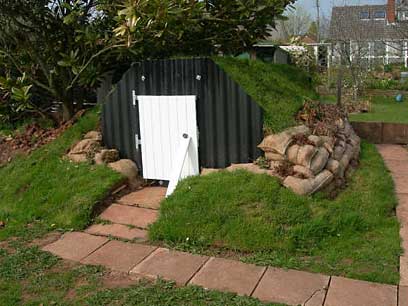Building an Anderson shelter.

The story starts in November, 1953, when as a two-year-old, I moved into the ground floor flat of 50 Balham Park Road, in London. It was a narrow three-story Edwardian house with a long garden backing onto the railway embankment of the main line to Clapham Junction and Victoria.
Balham was heavily bombed during the war, no doubt because of the railway line, and we often used to play on the bombsites. The fences between the gardens were all broken, falling down and even missing in places. The fence between us and Mrs Hampson’s, next door at number 52, was made of corrugated iron, badly rusted and there were many gaps.
Enjoy more Best of British Magazine reading every month.
Click here to subscribe & save.
At the bottom of the railway embankment in Mrs Hampson’s garden was an Anderson air raid shelter, which had been made into a rockery with terracotta garden gnomes and seashells. We often used to creep into her garden to retrieve our tortoises, which often escaped, and we used to peer down into the dark interior of the air raid shelter. It had a layer of leaves in the bottom, and a bench running up one side. We never dared enter, but it was always a great source of fascination and is still vivid in my memory fifty years later.
In the 1980s, my sister Barbara moved into a house in Westerham that had a sunken brick air raid shelter. Unfortunately, it was full of builder’s rubble, which was so compacted we were never able to clear it out.
My mother, who was a teenager in London during the Blitz, was in an air raid shelter in Victoria when a landmine came down just outside and blew the whole door off. When she died a couple of years ago, the memories reawakened in me a great interest in WWII.
While visiting the Norfolk Broads, we used to pass a former WWII aircraft museum in the garden of a house. Everything had been sold off, but there was still the reconstructed Anderson shelter in the garden, covered in weeds and stinging nettles. We approached the owners, who said we could have it if we dug it up and took it away. It was a huge job digging it out, undoing the rusty nuts and bolts, dragging the heavy panels into a trailer, and then towing them back to Somerset.
Unfortunately, some of the panels had been damaged in previous attempts to remove it using a wire hawser, so we set about trying to find some replacements. We were able to find some panels that had been used as a wood store at Oby Farmyard in Norfolk, and in Tipton, Wolverhampton, where a family wanted to get rid of an Anderson shelter that had been used as a bicycle shed. We also found others in use on allotments in Great Yarmouth, sailing club headquarters on the Norfolk Broads and riverside shelters.
Many weeks of de-rusting, painting and repairing took place, until at Christmas I was ready to start digging. A friend gave me some photocopies of original instructions on how to erect an Anderson shelter. This involved digging a hole seven feet six inches long by six feet wide, with a recommended depth of four feet. The instructions say you should get a neighbour to help, but I dug it myself, which was exhausting, throwing up a huge amount of soil. I could only get it to three feet deep, as there was nowhere else to put the soil!
The panels were exceedingly heavy – probably treble the thickness of ordinary corrugated iron – but I eventually got it all assembled. As they have a reputation for leaking badly through the bolt holes in the top, I covered the shelter in polythene and an old butyl pond liner. Then there was the huge job of filling it all in and covering it with soil to a depth of about a foot, with turves on top.
Anderson shelters are known for flooding, but I only experienced a trickle of water in the bottom throughout our heavy Somerset rain – that is, until a heavy snowfall, which was followed by torrential rain for 24 hours. This resulted in nine inches of water in the bottom of the shelter, which took a week to subside; but these are the same conditions that people had to put up with during the war!
I spent five nights sleeping in the shelter; it was very comfortable and not claustrophobic. I used a paraffin lamp to get the real 1940s’ experience. I can’t imagine what it would be like though with four or five people sleeping in there every night, as my camp bed took up half the floor. The beds and bunk beds people used would have to be very narrow or you couldn’t move.
I had a cosy night’s sleep in a sleeping bag with a hot water bottle and it was lovely to wake up to the sound of bird song when it got light. I fully realise that I was just playing at it, and can’t even begin to imagine the horrors of being inside one with bombs falling all around.
I wonder how many Anderson shelters are left. I imagine there are very few left in situ. Hopefully, with the amount of paint and bitumen I put on mine, it will last a very long time into the future.
Brian Eady
This article appeared in the June 2009 issue of Best of British.

